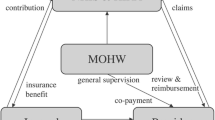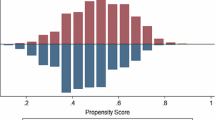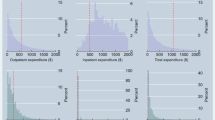Abstract
Does supplementary private health insurance (PHI) coverage influence health care utilization in countries where the coverage ratio with public health insurance is high? I estimate this effect using the Survey of Health, Ageing and Retirement in Europe. Handling the potential endogeneity of supplementary insurance coverage and the large fraction of zero observations in the utilization models influences the empirical results. I show that the effect of PHI coverage on inpatient and outpatient care utilization is not trivial even in countries with generous public health funding. The main finding is that supplementary PHI coverage increases dental care utilization, but decreases the visits to general practitioners. Private insurance is estimated to have little and insignificant influence on the utilization of inpatient care and outpatient specialist care. The magnitude of the effect of supplementary PHI on health care utilization varies with the characteristics of the health care systems.
Similar content being viewed by others
Notes
Details about the Survey of Health, Ageing and Retirement in Europe (SHARE) are provided in Sect. 5.
The WHO data are based on the WHO European health for all (HFA) database. In the WHO statistics, the public health expenditure measure for Switzerland includes the expenditures covered by mandatory PHI.
Jones et al. (2006) differentiate four influencing mechanisms of health insurance on utilization: (1) moral hazard effect due to reduced prices, (2) risk reduction effect due to reduced financial uncertainty, (3) income transfer effect (ex post transfer from the healthy to the ill) and (4) access effect due to the access to high quality services.
Two-stage modelling is a standard approach in modelling health care demand, see, e.g. Zimmerman Murphy (1987), Pohlmeier and Ulrich (1995) and Werblow et al. (2007). An alternative modelling strategy could be the application of finite mixture (latent class) models, as, e.g. Deb and Trivedi (1997). Such models allow for heterogeneity in the population, but do not apply strict separation between those who utilize and do not utilize health care services. Then the marginal effects are allowed to vary among ‘latent classes’ of the population. I apply the simpler two-part modelling approach, but extend that with handling the endogeneity of PHI coverage.
Alternative consistent estimation methods are the full-information maximum likelihood and two-stage method of moments estimation suggested by Terza (1998). Based on Terza et al. (2008), three conditions have to be satisfied for the consistency of the 2SRI method: (1) The identifying instruments cannot be correlated with the unobservable determinants of health care utilization. (2) The identifying instruments must be correlated with the PHI variable. (3) The identifying instruments might not have direct influence on the utilization measure, and might not be correlated with the random error term in the utilization model. These conditions are satisfied based on the assumptions that the characteristics of the last job have no direct effect on current helath care utilization, and these characteristics are independent of the unobservable determinants of utilization.
This article uses data from SHARE release 2.3.1, as of 29 July 2010. SHARE data collection in 2004–2007 was primarily funded by the European Commission through its 5th and 6th framework programmes (Project Numbers QLK6-CT-2001- 00360, RII-CT- 2006-062193, CIT5-CT-2005-028857). Additional funding by the US National Institute on Aging (Grant Numbers U01 AG09740-13S2, P01 AG005842, P01 AG08291, P30 AG12815, Y1-AG-4553-01, OGHA 04-064, R21 AG025169) as well as by various national sources is gratefully acknowledged (see http://www.share-project.org for a full list of funding institutions).
This approach is a simplification, as it neglects the uncertainty of the imputations, therefore can cause downward bias in the estimated standard errors. However, this simplification does not affect the main results of the article.
As PHI is predetermined in this model, it is reasonable to subtract its costs from the disposable income measure. I replace the net income to one for whom its calculated value is zero or negative (there are 63 such observations in the sample used). The median value of annual payments for PHI contracts is 356 EUR, the mean is 596 EUR among those who report supplementary or complementary PHI coverage.
The chronic conditions are heart attack, high blood pressure, high blood cholesterol, stroke, diabetes, chronic lung disease, asthma, arthritis, osteoporosis, cancer, stomach ulcer, Parkinson disease, cataracts, hip or fremoral fracture. The ADL limitations include difficulties with dressing, walking across a room, eating, bathing, getting in or out of bed, and using the toilet. The specified symptoms are pain in a joint, heart trouble, breathlessness, persistent cough, swollen legs, sleeping problems, falling down, fear of falling down, dizziness, stomach problems and incontinence.
Based on the estimated marginal effects at the average, the probability of having PHI is 5 % points higher if the firm size is above 500 employees than if the firm size is between 200 and 499. The increasing effect of self-employment (compared to private sector employment) at the average is 7 % points.
The detailed estimation results can be requested from the author.
I also test the difference between the probit and bivariate probit PHI coefficients using the bootstrap Hausman test, following Cameron and Trivedi (2009, pp. 429–430). The test indicates for all four types of health care that the estimated PHI coefficients under the two specifications do not differ significantly. This implies that the exogeneity of PHI in the first stage of utilization cannot be rejected.
The estimation results are consistent if the regressors other than PHI, and the characteristics of the previous job are exogenous. In order to test the validity of the exogeneity assumptions, it is possible to calculate the nonlinear version of the Sargan test, suggested by Cameron and Trivedi (2005, p. 277). The test fails to reject the exogeneity assumptions.
The mfx command of Stata is used when calculating the marginal effects. The significance levels of the marginal effects in the two-part models are based on bootstrapped standard errors. The Stata codes of Deb et al. (2010) are used as basis for the bootstrapping procedures, with 1,000 replications.
The contribution of the \(i\)th observation with nonzero utilization to the likelihood is
$$\begin{aligned} \Pr (Y_{ji},\mathrm{{Pos}}\_Y_{ji}&= 1,\mathrm{{PHI}}_{i}=l|X_{i},Z_{i})\\&= \int \Pr (Y_{ji},\mathrm{{Pos}}\_Y_{ji}=1,\mathrm{{PHI}}_{i}=l|X_{i},Z_{i},\tilde{\varepsilon } _{2ji})\phi (\tilde{\varepsilon }_{2ji})\mathrm{{d}}\tilde{\varepsilon }_{2ji}\\ \!&= \!\int \frac{\exp (-\lambda _{ji}(\tilde{\varepsilon }_{2ji}))\lambda _{ji}( \tilde{\varepsilon }_{2ji})^{Y_{ji}}}{Y_{ji}!}\Pr (\mathrm{{Pos}}\_Y_{ji}\!=\!1,\mathrm{{PHI}}_{i}\!=\!l|X_{i},Z_{i},\tilde{\varepsilon }_{2ji})\phi (\tilde{ \varepsilon }_{2ji})\mathrm{{d}}\tilde{\varepsilon }_{2ji}. \end{aligned}$$\(\phi (\cdot )\) is the normal probability density function with mean zero and variance \(\sigma ^{2}\), and \(l\) equals 0 or 1. The second term in the last integral can be expressed as a function of \(\tilde{\varepsilon }_{2ji}\), using the first stage bivariate probit estimation results, and the assumption of multivariate normality. In order to simplify the estimation procedure, I apply two-stage maximum likelihood estimation—I estimate the bivariate probit model of Eqs. (1) and (2) in the first stage, and use these estimation results as known in the second stage. In the simulations, I use 100 draws from the Halton sequence with prime number 7. For producing the Halton draws I use the Stata code mdraws written by Cappellari and Jenkins (2006). Cappellari and Jenkins also discuss the advantages of Halton draws in MSL estimation.
References
Bago d’Uva T, Jones AM (2009) Health care utilisation in Europe: new evidence from the ECHP. J Health Econ 28:265–279
Cameron AC, Trivedi PK (2005) Microeconometrics: methods and applications. Cambridge University Press, New York
Cameron AC, Trivedi K (2009) Microeconometrics using Stata. Stata Press, College Station, TX
Cappellari L, Jenkins SP (2006) Calculation of multivariate normal probabilities by simulation, with applications to maximum simulated likelihood estimation. Stata J 6(2):156–189
Deb P, Trivedi PK (1997) Demand for medical care by the elderly: a finite mixture approach. J Appl Econom 12:313–336
Deb P, Manning W, Norton E (2010) Sample programs for ASHE June 2010 at Cornell University Ithaca
Dow MH, Norton EC (2003) Choosing between and interpreting the Heckit and two-part models for corner solutions. Health Serv Outcomes Res Methodol 4:5–18
Gibbons RD, Wilcox-Gok V (1998) Health service utilization and insurance coverage: a multivariate probit analysis. J Am Stat Assoc 93(441):63–72
Greene WH (2003) Econometric analysis, 5th edn. Prentice Hall, Upper Saddle River, NJ
Grossman M (1972) On the concept of health capital and the demand for health. J Polit Econ 80:223–255
Holly A et al. (2005) Out-of-Pocket Payments for Health Care Expenditures. In: Börsch-Supan A et al. (eds) Health, aging and retirement in Europe - first results from the survey on health, aging and retirement in Europe. MEA, Mannheim , pp 126–132
Hullegie P, Klein TJ (2010) The effect of private health insurance on medical care utilization and self-assessed health in Germany. Health Econ 19(9):1048–1062
Hunt-McCool J, Kiker BF, Ng YC (1994) Estimates of the demand for medical care under different functional forms. J Appl Econom 9(2):201–218
Jones AM (2000) Handbook of health economics. In: Culyer AJ, Newhouse JP (eds) Health econometrics, vol 1, chap 6. Elsevier, Amsterdam, pp 265–344
Jones AM, Koolman X, van Doorslaer E (2006) The impact of having supplementary private health insurance on the use of specialists. Ann Écon Stat 83(84):251–275
Manning WG et al (1987) Health insurance and the demand for medical care: evidence from a randomized experiment. Am Econ Rev 77(3):251–277
Mossialos E, Thomson S (2004) Voluntary health insurance in the European Union. WHO, European Observatory on Health Systems and Policies
Norton EC, Dow WH, Do YK (2008) Specification tests for the sample selection and two-part models. Health Serv Outcomes Res Methodol 8:201–208
OECD (2004) Private Health Insurance in OECD Countries. The OECD Health Project
Paccagnella O, Rebba V, Weber G (2012) Voluntary private health care insurance among the over fifties in Europe: a comparative analysis of SHARE data. Health Econ. doi:10.1002/hec.2800
Pohlmeier W, Ulrich V (1995) An econometric model of the two-part decisionmaking process in the demand for health care. J Hum Resour 30(2):339–361
Rodríguez M, Stoyanova A (2004) The effect of private insurance access on the choice of GP/specialist and public/private provider in Spain. Health Econ 13(7):689–703
Terza JV (1998) Estimating count data models with endogenous switching: sample selection and endogenous treatment effects. J Econom 84:129–154
Terza JV, Basu A, Rathouz PJ (2008) Two-stage residual inclusion estimation: addressing endogeneity in health econometric modeling. J Health Econ 27:531–543
Thomson S, Foubister T, Mossialos E (2009) Financing health care in the European Union. WHO, European Observatory on Health Systems and Policies
Werblow A, Felder S, Zweifel P (2007) Population ageing and health care expenditure: a school of ’red herrings’? Health Econ 16:1109–1126
Zimmerman Murphy M (1987) The importance of sample selection bias in the estimation of medical care equations. East Econ J 13:19–29
Acknowledgments
An earlier version of this article was written as part of my Ph.D. thesis at the Central European University. I am grateful for comments and suggestions received at the 5th Nordic Econometric Meeting in Lund, 3rd annual conference of the Hungarian Society of Economics in Budapest, 2nd Health Econometrics Workshop in Rome and from two anonymous referees.
Author information
Authors and Affiliations
Corresponding author
Appendix
Appendix
Rights and permissions
About this article
Cite this article
Bíró, A. Supplementary private health insurance and health care utilization of people aged 50+. Empir Econ 46, 501–524 (2014). https://doi.org/10.1007/s00181-013-0689-2
Received:
Accepted:
Published:
Issue Date:
DOI: https://doi.org/10.1007/s00181-013-0689-2




